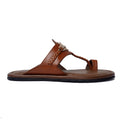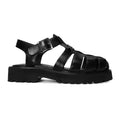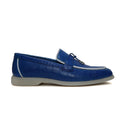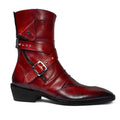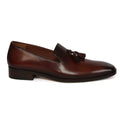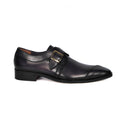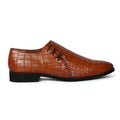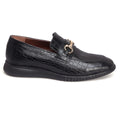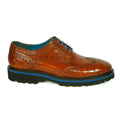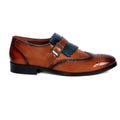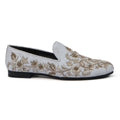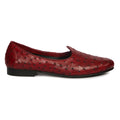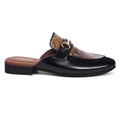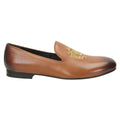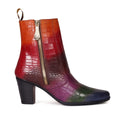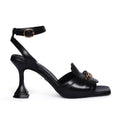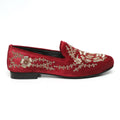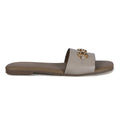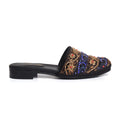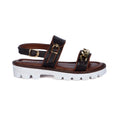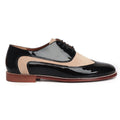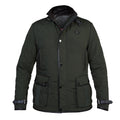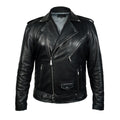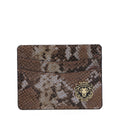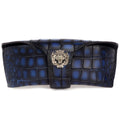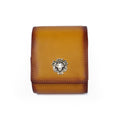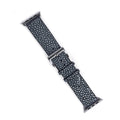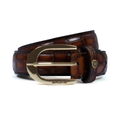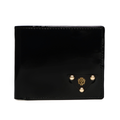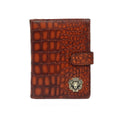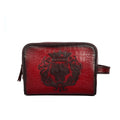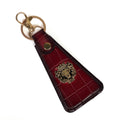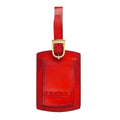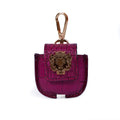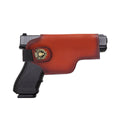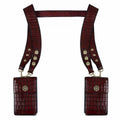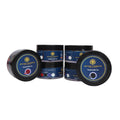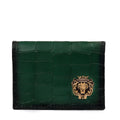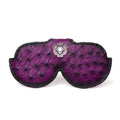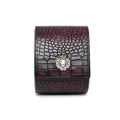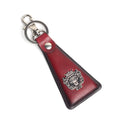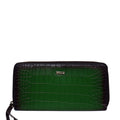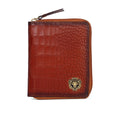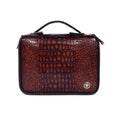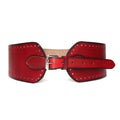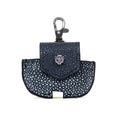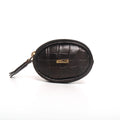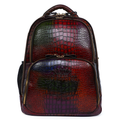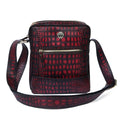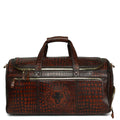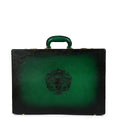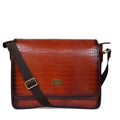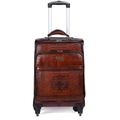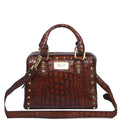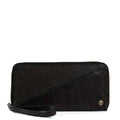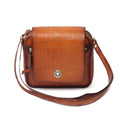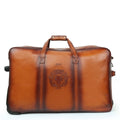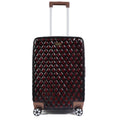We will send you an email to reset your password.
Search our store
Leather Care
SHOES
Proper care and maintenance of leather
shoes will help to ensure their longevity in wear. We would recommend
that you follow the general guidelines below:
- Please keep
your shoe away from prolonged intense sunlight, heat & humidity.
Exposure to water, oil & permanent dyes can also stain tanned
leathers. - To rejuvenate the leather, use leather cream at least once a week & clean the shoes with a dry cloth before applying it.
- Wear your leather shoes on alternate days or wait at least 12 hours to wear them again to give them time to breathe.
- Leather
shoes can often take a day to dry out fully whether from rain or
natural perspiration. If in case, you cannot avoid the rain or snow then
please wear galoshes to protect the shoes. - Store the shoes with
a cedar or poplar shoe tree. A shoe tree absorbs moisture and odor
while keeping the shoe’s proper shape to prevent creasing. - Shoe
creases: When the crease is fresh and minor then massage the shoe with a
leather friendly oil until the crease disappears completely. - A shoe horn can help to prevent damage to the heels, counter and top line.
- Our
shoes are hand painted on natural color, mild fading is expected &
regular shoe polishing is advised to retain the shine & color. As
leather is a skin, regular polishing helps to keep it moist &
prevents it from cracking.
LEATHER SOLES
Leather
soled shoes require special care and the reason is simple that leather
as a natural material is absorbent. It is a skin and no matter what is
said or done, it should be emphasized that skin is not waterproof.
Please be advised that the products that have wrinkles/marks/scars as a
result of wear and tear are not considered to be faulty.
- Avoid
water contact as it expands when wet. In the event that your leather
soles do become very wet, ensure that they are allowed to dry out slowly
and naturally, away from direct heat source. - Use a dry soft
cloth or brush to remove dirt particles and clean the sole with a moist
cloth afterwards. Dip the cloth in a mixture of 50% water and 50%
vinegar and rub the spots until they are completely removed. - You
can also apply mink oil and make sure it covers every part of the sole.
The oil will aid in waterproofing the leather. Wipe off the excess oil
with a dry cloth and let it dry naturally. - To retain the sole's
moisture, apply clear polish to the sole, the same polish that you use
on your shoes, once a month to prevent it from drying out. - If
your leather soles are very dry, you can also use a dab of leather
grease to moisturize them, massaging the leather with a soft cloth. To
finish this treatment, be sure to also apply a leather-conditioning
cream to the welt and heel.
Cleaning and maintaining
leather shoes entails more than simply applying leather conditioner and
finishing with a spray or shoe polish. For starters, different types of
leathers are used on shoes. Furthermore, each of these types must be
cleaned in a different manner than the others:
1.Leather uppers
- These
require regular treatment with a good-quality wax polish to protect the
leather and give a high shine finish. This should help to prolong the
life of the uppers and maintain their appearance. The shoes should be
dry before application. - Try to avoid using unsuitable liquid
polish applicators on high quality leather uppers as these can
potentially damage the surface of the leather and often create a lacquer
which is hard to remove.
2.Suede and Nubuck uppers
- These can be treated using a 'Suede Protector' spray.
- Use a rubber eraser on your suede leather shoes to remove smudges and dirt.
- A
rubber suede brush can help to lift any dirt and debris, however,
stubborn stains may require treatment with a suede shampoo. Make sure to
brush in one particular direction instead of back and forth to preserve
suede’s unique properties. - Suede can often be revived using steam from the kettle and gently cleaned with a rubber suede brush. [Don't use a wire brush]
3.Waxed-finished or waterproof leather uppers
- These should be treated with dubbin or a 'waxed leather cream' to condition, soften and protect the leather.
- Usually there is no need to use a colored polish on this type of leather as it is not supposed to have a high shine.
4.Patent Leather
- Wipe the shoes with a soft damp cloth.
- Then,
your shoes should be treated with leather cleaner and conditioner
formulated for patent leather. It should specifically contain silicone
to restore its high gloss look.
BAGS
1.Conditioning and protecting your leather bag
- Rub conditioner into your bag once a month. Leather conditioner helps to stop your bag from cracking and drying.
- Weatherproof
your bag by adding beeswax or a spray protectant. Leather is not
waterproof, and will absorb moisture like rain or humidity. If you are
using a beeswax cream, test it on a small corner of your bag to make
sure it doesn’t alter the color before you put it on the entire thing.
2.Extending the life of your bag
- Avoid
using your leather bag all the time. Keep rotating the bags in use.
Ideally a leather bag should be only used 2-3 times a week. - Let
water spills dry naturally without added heat. If you get any rain or
water from a spill on your leather bag, don’t try to dry it with heat.
Instead, wipe the majority of it off with a clean cloth and let the rest
air dry. - Please keep your bag away from prolonged intense
sunlight, heat & humidity. Exposure to water, oil & permanent
dyes can also stain tanned leathers impacting its durability.
3.Removing dirt and stains
- Gently dab your bag with a soft dry cloth to clean.
- Wipe down your bag with leather cleaner if it’s really dirty.
- Take
care of the stains immediately. If it's a grease stain use a generous
amount of cornstarch on the stained area. Cornstarch naturally absorbs
grease and won’t harm your leather bag in the process.
4.Storing your bag
- Always
put your bag in a dust bag/cotton pillow case with paper fillers
/bubble wrap while storing to help retain its shape. Air your bag out
every 2 weeks to avoid mold and mildew. - Place silica packets with your bag to remove moisture. {You can get silica packets from general goods stores or online}.
JACKETS
1.Maintaining your jacket
- Make
your leather water resistant. There are many "leather protector" or
"leather waterproofing" products, but read the label carefully before
buying. A silicone polymer spray or an acrylic copolymer spray should
preserve your leather's appearance and shine. - Apply a branded leather conditioner occasionally; do not wash.
- Let wet leather air dry. Apply conditioner after drying, if the leather had become thoroughly soaked.
- Minor
wrinkles should be avoided and removed by hanging the garment. It is
advised to take the jacket to a specialized leather cleaning if major
wrinkles bother you. Alternately, place a cloth below the leather and
quickly and briefly iron the cloth using a clothes iron set to the
lowest setting (typically marked "rayon").
2.Cleaning your jacket
- Use
a damp cloth to remove dirt, grease, and minor stains. Avoid
over-wetting and blot rather than rub. The leather should be dried
naturally, but don't let it remain damp for long. - Clean suede
with a specialized brush or a dry sponge. "Suede brushes" can remove
light grime (layer of dirt) from suede, but may scratch other leather
materials. You can try using a dry sponge as a cheaper option. - An
eraser can also be rubbed over grime in order to remove it. Usually
sold as artist's eraser," and is available at crafts stores. - Remove
mold with rubbing alcohol or mild soap. If a leather jacket is covered
in mold, which usually appears as a white or gray fuzz, mix equal parts
water and rubbing alcohol.
3.Storing your jacket
- Hang
your jacket properly. Never fold your jacket for an extended period of
time as this can cause creases & cracks in the leather. - Please keep your jacket away from prolonged intense sunlight, heat & humidity.
- Make
sure the leather can "breathe." Leather will last longer if exposed to
dry air. Never store leather inside a plastic bag or underneath a
plastic sheet. - Dry clean the jacket before moving it to a long term storage.
DISCLAIMER
Leather
is a natural material; color & shade variations may appear with
regular use. It is normal for leather to change color & show signs
of wear. Genuine leather has features such as stretch marks, scars,
scratches, wrinkles, & even insect bites that were acquired
throughout the animal's existence. The distinctiveness of fine leather
is that no two pieces are alike. The color & consistency differences
shouldn't be considered defects but rather as part of the leather's
inherent qualities. As the leather ages naturally it may develop a
patina, which will further enhance the personality of the product. If
stored in a humid environment, a thin, white film may form but it is
easily removed with polishing/cleaning with a damp cloth.

